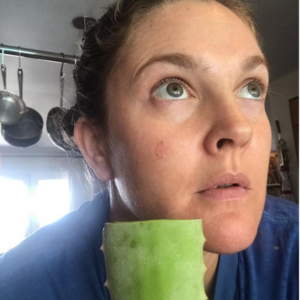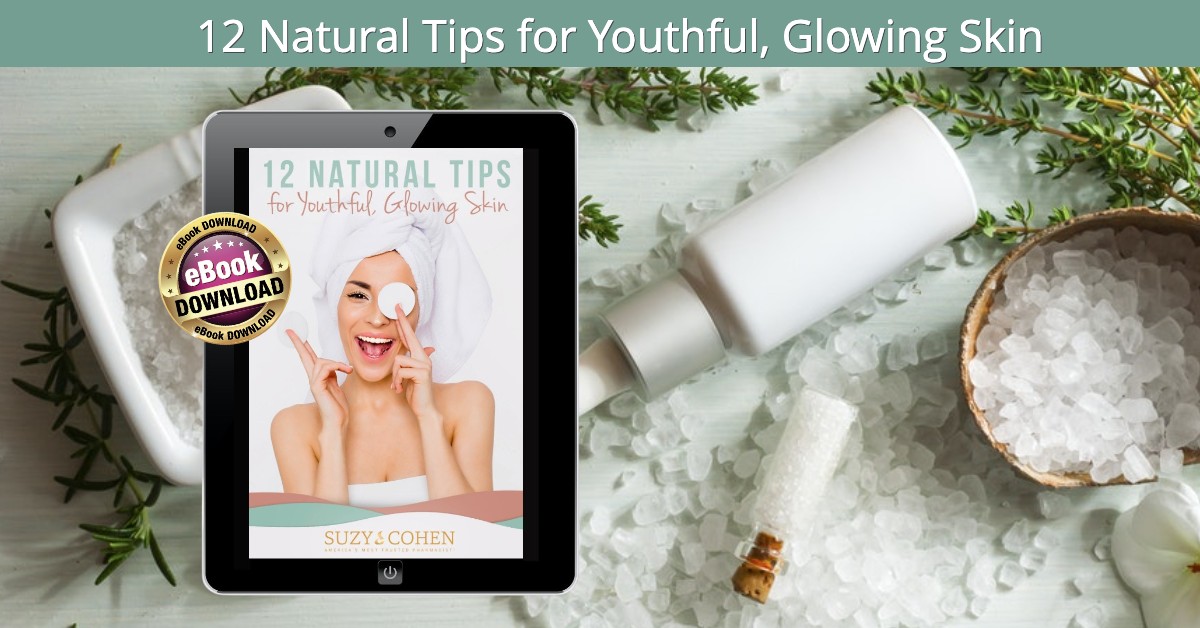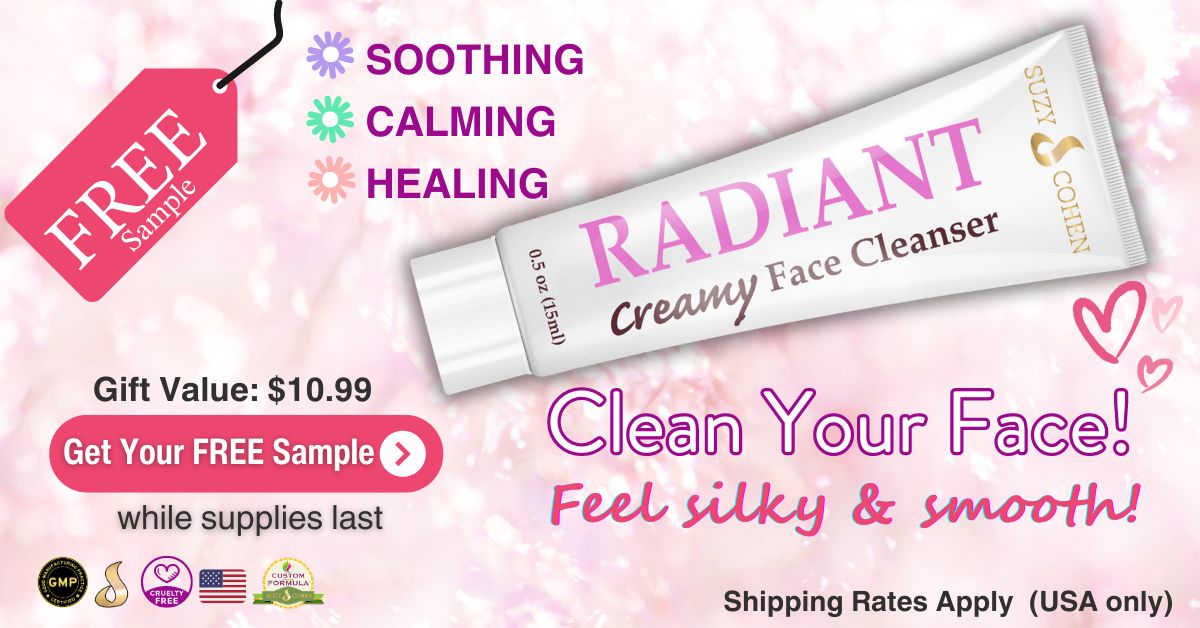Aloe vera made a couple of headlines recently. The first was when the actress Drew Barrymore dabbed some on a facial sore and it instantly took out the redness. The second was when Prop 65 regulations in California called out a known carcinogen in aloe vera called “aloin.”
Don’t worry, aloe will never get banned!
Not to be morbid from the get-go, but extracted compounds from this spiky succulent were used in the middle east to clean dead bodies and prepare them for burial. Aloe has been mentioned for centuries in Greek, Chinese, Moroccan, Indian and even Roman cultures.
Aloe used to belong to the Lily family of plants, but it was re-classified in 2009 to Xanthorrhoeaceae, which includes other plants that have leafless stalks. It’s quite possibly the first herbal medicine that kids encounter when mom breaks off an aloe stem from a little house plant to slather it on a wound. Do you remember aloe getting put on you?
For most people, aloe is very soothing, but there are some people who have sensitive skin and sometimes react badly to it. It’s very unusual though. Aloe vera is a generally harmless, and usually helpful! I do.
My mom always had aloe on the windowsill or growing in the garden. Aloe is best known for it’s soothing and skin-healing benefits. It’s moisturizing too and in fact, some skin care lines use it in their lotions, face cream and sunburn relief formulas.
Aloe Has Two Useful Parts
Plants of aloe very give us two different substances, one is called “gel” and the other is called “latex. Both have medicinal value. The gel is the clear part that comes from the center of the leaf. You know it well… it looks like jelly and it’s what you put on the skin for cuts and minor burns. The aloe latex is visible just beneath the plant’s outer skin, and it’s yellow in color. This has a laxative effect on the body, and is frequently found in commercial laxatives that use aloe.
Aloe and Psoriasis
Psoriasis is an auto-immune disorder of the skin that is very difficult to treat, even if you minimize typical food allergens like gluten, soy, egg and dairy. The use of aloe vera has been very well studied in patients with psoriasis.
In 2017, there was a complete review of medicinal plants that help psoriasis.
This paper was published in the American Journal of Clinical Dermatology (Aug 2017). Scientists scrutinized 27 different clinical trials that involved topical plant-derived treatments for psoriasis. They concluded that of ALL the different botanical agents, three of them stood out as the most effective natural treatment for symptoms of psoriasis, however, depending on the patient, some people experience minor side effects from these (redness, burning and mild pain).
The 3 Most Effective Plants for Psoriasis
1. Oregon Grape (Mahonia aquifolium)
2. Indigo naturalis (Strobilanthes formosanus)
3. Aloe vera (Aloe barbadensis)
The Indigo naturalis extract was written up again in Molecules 2013, and found to have an impact of MRSA which is really hard to treat, and sometimes fatal, that’s why I am randomly mentioning it here for you. It’s a fascinating extract this indigo, because it was shown in another study to down regulate IL-17, a nasty pro-inflammatory cytokine that is elevated in people with psoriasis.
In 2015, another review on aloe was conducted and the findings published in Phytotherapy Research (May 2015). The researchers were aware at the outset that conventional pharmacological treatments for psoriasis have limited effectiveness. Four trials were reviewed and the scientists concluded that using aloe vera was “generally well tolerated” and “no serious side effects were reported.”

Drew Barrymore and Aloe
Recently, the actress Drew Barrymore used aloe gel on her face to reduce redness from a sore on her cheek.
Aloe Vera is a Huge Business
You may think of it as a spiky plant in the yard, or in your home but this is a big business. It’s actually huge! There are well-designed marketing campaigns to increase global and sales. There are reports that people in the industry can buy comprehensive analytical reports for the sole purpose of learning about technological trends, the competitive landscape, size and growth of various market segments, forecasting of sales as well as the major drivers (and challenges) for commercial use of aloe vera products. None of that is a big deal if your finger hurts and you want to put aloe on it! Go for it! Everything is a business nowadays. Who cares if aloe vera growers want an edge?!
I love this plant for so many reasons. Today I want to tell you about some interesting health benefits that could improve your health, or that of someone you love. I’ll also have a few warnings for you.
Aloe in Trouble with Prop 65 Aloe vera growers and manufacturers are champing at the bit to make more and more products, but there’s one state that is giving them trouble. It’s California, and it’s due to Prop 65 regulations which protect residents from chemicals known to cause cancer. Do I personally think aloe’s going to get banned? No, not a chance, but according to Prop 65 legislation, it essentially means that carcinogenic compounds have to be called out so that California residents know they’re in a product. Some compounds are actually banned.
So the aloe story goes like this. It’s a completely natural plant, but the component of aloe vera that is “non-decolorized, whole leaf extract” that contains “aloin.” In rats, it can cause cancer when ingested. But the good news is that this part of aloe is most often used topically, it’s not ingested.
Prop 65 RULES are probably not going to take away aloe-containing cosmetic products, but I want you to be aware, just like I made you aware of how Prop 65 rules were forcing Starbucks and other cafes to warn visitors that their coffee might cause cancer! If you’d like to see how Prop 65 rules impact Starbucks and other cafes in California, CLICK HERE to read my rant on this, Judge Rules Coffee Shops Must Display Cancer Warning.
11 Ways to Make Use of Your Aloe Plant
1. Moisturize Yourself
Apply a dab of aloe gel (the size of a quarter) onto your skin directly, or mix it in the palm of your hand with your favorite lotion. This is great on freshly shaved skin.
2. Heal Bug Bites
Dab aloe gel directly onto painful or itchy mosquito bites or bee stings. You can also make your own itch-relief cream by combining the aloe vera gel in the palm of your hand with some hydrocortisone cream. Just mix it with your finger and dab it onto all the bug bites. If you’d like a recipe for an even stronger home-made bug bite cream use my favorite concoction here.
Suzy’s Aloe Bug Buster Cream
Ingredients
1/4 cup baking soda
2 tablespoons aloe vera gel
2 tea witch hazel
1 tea meat tenderizer powder
2 drops eucalyptus essential oil
2 drops essential oil of tea tree
5 drops lavender essential oil
Directions: Mix this together and if you need to, you can add a little bit of water to it. The goal is to make a smooth paste so that you can rub it on to the bug bites. It’ll keep in your fridge for about month or two.
3. Cool off burns
You can buy a burn relief ointment or antibiotic ointment from any pharmacy. Squeeze a dab of that onto your palm, and mix in some aloe vera gel. When the consistency is uniform, dab it onto your minor burn.
4. Soothe eczema itch
You can buy any salt or sugar scrub that feels good to you and just mix in aloe vera gel. I’d mix it as a 25:75 ratio meaning 25% aloe vera plus 75% scrub. Apply to itchy spots. You might want to test it first before applying to large areas.
5. Remove dandruff
Find a selenium sulfide-based shampoo for dandruff. Add some aloe vera gel to the shampoo and immediately apply massage to your scalp. If you have it, mix in a drop or two of tea tree oil. Shampoo like normal and condition if desired. This is temporarily helpful, it is not a cure.
6. Fix gingivitis
To have healthy gums try this trick. Squeeze some aloe vera gel onto your toothbrush and brush like normal. You can do this after you brush your teeth at bedtime. It promotes healthier gums.
7. Shave your legs
Instead of using expensive, perfumed shaving cream on your legs, you can try just plain aloe vera gel. Your legs will feel silky smooth because the aloe vera doubles as a moisturizer.
8. Get moving
If you have constipation, aloe vera is known for it’s laxative effects. There are commercially prepared products used as dietary supplements which some people can tolerate and others should not even attempt. I know that sounds strange because the Internet is buzzing with accolades for aloe vera and how it can cure constipation. But nevertheless, the American Cancer Society sale aid there’s a lack of proper evidence and has suggested a ban of aloe vera products for this purpose.
But the irony of that last comment is this: The German Commission E (which is like the FDA here in the US) has actually approved aloe vera for the treatment of constipation. So which is it, useless or great? It depends on what you want to believe.
According to the University of Maryland Medical Center, aloe juice or latex can cause painful stomach cramping (and possibly constipation) due to its powerful laxative properties. That part is actually true for some folks. Each person reacts differently to herbs and vitamins, we are all individual. People have been known to juice with fresh aloe, it’s quite common. I do not recommend juicing with a lot of aloe, like a big stalk… at least not at first. It can be overwhelming to your system.
I tried it about 10 years ago, and all I remember is that I got mild abdominal cramps for several hours. My husband Sam, drank the same carrot juice with the aloe in it, and he had no effect whatsoever. That’s what I’m saying, everyone is unique.
Please be careful when experimenting with new supplements and health protocols and if you have a medical condtion, be sure to ask your doctor about it. Aloe vera, especially in high amounts, has been known to cause abdominal cramps, severe and/or diarrhea and throat swelling. A lot of people don’t know that, they just indiscriminately juice with it, or blend it into a smoothie and then BAM! It’s specifically due to the yellow “aloe latex” portion.
9. Succulent Facial
Do you want softer skin and more radiance without spending a fortune on fancy creams? Sometimes I need this in the very cold months here in Colorado. I just apply the gel straight on to my face and rest for 15 minutes (avoid your eye area). Rinse it off and pat dry. This will not only help moisturize your face, it will help control acne. Aloe is thought to promote collagen production, but it’s a slight effect, nothing like taking collagen internally.
10. Soothe a sunburn
It’s a fantastic plant to keep around the house in case of sunburn. If you’re red and hot from too much fun in the sun, snap off a stalk from your aloe plant and apply the clear gel onto your skin. It acts like a cooling balm and reduces redness and inflammation. You might also need ibuprofen, aspirin or acetaminophen if you’re really on fire.
11. Thaw Frostbite
If it’s mild, you might feel cold, tingly or painful skin. Serious cases will cause white, hard or numb skin and this requires medical care by a doctor. But very mild frostbite on the fingertips, tip of your nose or cheeks, or outer ears might be easy enough to fix. I can’t determine that from here so use common sense and obviously get medical attention if you need it.
For simple cases, like when you go outside and do a snow angel and feel like you got frost bitten on your ears… just move back inside the house into a warm room and put a warm wet towel on your ears for 15 minutes, that quickly warms them up. You want wet heat, for example if it’s your finger or toe, put it in a sink (or bathtub) filled with very warm water, not hot where you could burn yourself! Just warm water, and you’ll want to soak it for 15 to 30 minutes.
The prescription medication Pentoxifylline (brand Trental) used to be the drug of choice to help with frostbite because it increases blood flow to capillaries, getting blood to frost-nipped areas. A study back in 1995 (when I was still in pharmacy school) showed how helpful this medication was, and that it worked just as well as aloe vera cream. Another older protocol for frostbite consists of topically applied aloe vera gel along with aspirin. The aloe vera works because it blocks thromboxane, which helps increase blood flow to the frost-bitten areas. Since those times, we’ve come a long way with the various different medications used for frostbite, but one thing still holds true. Aloe vera works for mild frostbite.
Aloe Vera and Diseases
Food Allergies
A lot of you have a hypersensitivity to certain food allergens, for example gluten, eggs, mangos or shellfish. Aloe vera has polysaccharide compounds known to enhance immunity and RESEARCHERS decided to test the theory out on mice to see if it could reduce food allergies. They evaluated the reactions of the animals based upon allergic symptoms, rectal temperature and occurrence of diarrhea.
The RESULTS showed that aloe vera could suppress T helper 2 cell serum concentration, histamine reductions, mast cell release and infiltration of eosinophils into the intestine. It did another good thing, it stimulates section of protective IL-10 (interleukin 10). Taken together, aloe vera helped mitigate the harm caused by food allergens in mice by increasing ‘calming’ chemicals in the immune system, while reducing bad ones.
Type 2 Diabetes
Insulin resistance is associated with the death of pancreatic β-cells and inadequate insulin production. A brand new study (June 2018) published in Biochemical and Biophysical Research Communications evaluated the polysaccharides from aloe vera and found very positive benefits, at least with animals.
The rodents who received aloe vera experienced a modulating effect on their pancreatic β-cells and had lowered FBS (fasting blood sugar) levels. If we were to extrapolate, we could say that aloe vera seems to have a protective effect on the insulin-producing cells of animals, and perhaps for people with Type 2 diabetes.
Gingivitis
It’s not entirely conclusive, however scientists EVALUATED results from 79 scientific papers and deduced that aloe vera appears to help reduce plaque and gingival inflammation. This makes it a natural remedy for patients suffering from gingivitis.
Gastritis
Aloe vera may have a protective effect on the stomach lining. In an animal model STUDY, it was able to reduce the otherwise terrible damage induced by oxidative stress and inflammation. This might mean that it could help people with gastritis. The researchers did not test aloe vera on an actual ulcer, but rather an induced gastropathy from a drug called indomethacin.
Unexpected Problems and Cautions with Aloe Vera
Skin allergies if you apply it topically and you’re sensitive
Eye swelling if you use it as a masque and you’re sensitive
Dehydration if you use it regularly as a laxative
Hypoglycemia because the supplements might reduce blood sugar too quickly
Severe and/or bloody diarrhea if sensitive to supplementation or pure aloe leaf from the plant

Suzy Cohen, has been a licensed pharmacist for over 30 years and believes the best approach to chronic illness is a combination of natural medicine and conventional. She founded her own dietary supplement company specializing in custom-formulas, some of which have patents. With a special focus on functional medicine, thyroid health and drug nutrient depletion, Suzy is the author of several related books including Thyroid Healthy, Drug Muggers, Diabetes Without Drugs, and a nationally syndicated column.



